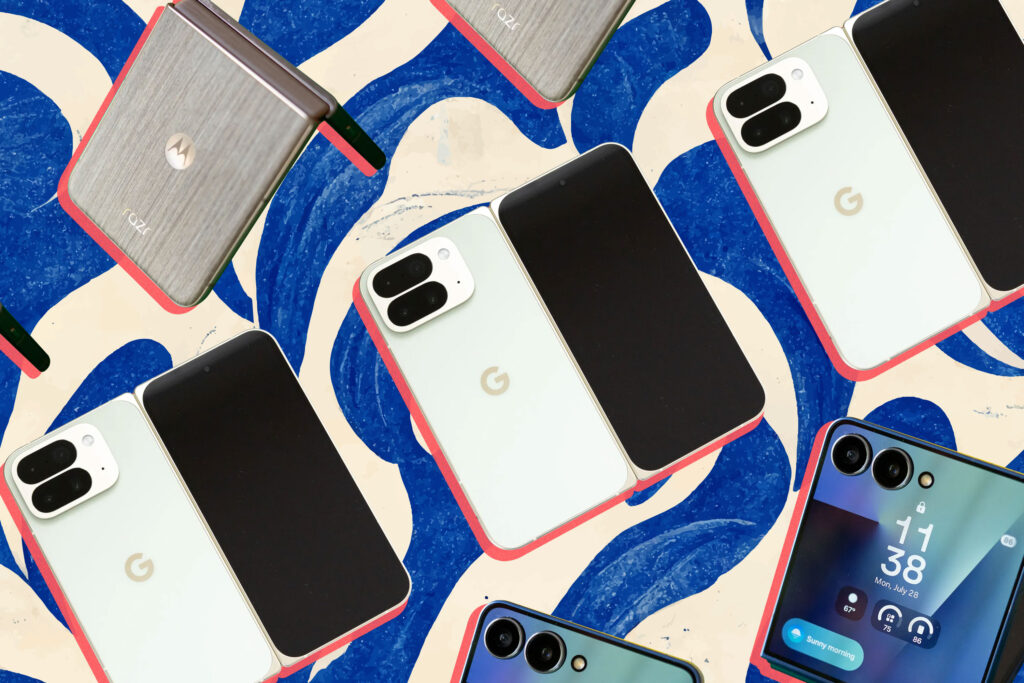
A foldable phone isn’t for the faint of heart. They’re generally heavier, pricier, and have less capable cameras than a standard slab-style phone. They’re also still not as durable as regular smartphones, though they’re not nearly as fragile as they once were. In fact, thanks to Google, we finally have a foldable phone we can take with us to the beach.
There are basically two kinds of foldables at the moment — the kind that fold like books and the ones that fold clamshell style, like your old flip phone. Here’s how I think of it: a book-style foldable is like a phone plus a tablet, and a flip-style foldable is a phone plus a smartwatch. The book foldables provide an outer screen for all your regular phone needs, and then a tablet-like inner screen when you want, well, more screen. Flip phones come with a smaller secondary display on the outer panel that’s useful for checking information quickly. When you need to do regular phone stuff, you unfold it.
So while they all fit in one category of folding tech, they’re suited to two very different kinds of people — someone who wants even more phone with their phone and someone who wants to be fully immersed a little less. Whichever category you fit into, you’d be wise to get the manufacturer’s extended warranty with your purchase; fixes can be expensive, and you won’t be able to walk into just any phone repair shop to get them. If you don’t opt for the warranty, you’ll want to be sure you can comfortably afford to replace your phone in the event of a sudden sand-related catastrophe. Death can come swiftly to a folding screen.
If I haven’t scared you off by this point, then you’re probably the kind of person who will have a heck of a good time with a foldable. I’ve used every phone under the sun, and folding phones are some of my favorite gadgets. Run four apps at once! Prop it up like a tiny laptop! Hold it like a camcorder when you shoot video! There are tons of possibilities, and the thrill you get when you fold your phone shut never fully wears off.
Best book-style foldable
Google Pixel Pro 10 Fold

Score: 8
| Pros | Cons |
|---|---|
|
|
Where to Buy:
Screen: 8-inch, 2076p, 120Hz OLED inner screen; 6.4-inch, 1080p, 120Hz OLED cover screen / Processor: Google Tensor G5 / Cameras: 48-megapixel f/1.7 main with OIS; 10.8-megapixel 5x telephoto with OIS; 10.5-megapixel ultrawide; 10-megapixel selfie (cover screen); 10-megapixel inner selfie camera / Battery: 5,015mAh / Charging: 30W wired, 15W wireless (Qi2) / Weather resistance: IP68
Durability has long been the North Star of the foldable category, and the Pixel 10 Pro Fold marks a real milestone in that journey. With an IP68 rating, it’s the first foldable to offer full water and dust resistance. That means you can take the $1,799 device on a hike or to the beach without worrying that a stray grain of sand will absolutely destroy it. Add in Qi2 support with built-in magnets for accessories and wireless charging — along with Google’s more powerful Tensor G5 chip — and you have the most well-rounded foldable available.
The Pixel 10 Pro Fold isn’t without its shortcomings, though. It offers all-day battery life with minimal use of the inner display; however, if you spend most of your time using the inner screen, your battery will likely be in the red by bedtime. Also, while we love the device’s improved durability, its cameras fall short of Google’s other 10 Pro models, especially in low light. The foldable is a bit heavier and thicker than the Galaxy Z Fold 7, too, which is a fair trade for greater peace of mind.
Read our full Pixel 10 Pro Fold review.
Best flip-style foldable
Samsung Galaxy Z Flip 7

Score: 8
| Pros | Cons |
|---|---|
|
|
Where to Buy:
Screen: 6.9-inch, 1080p, 120Hz OLED inner screen; 4.1-inch, 948p, OLED cover screen / Processor: Samsung Exynos 2500 / Cameras: 50-megapixel f/1.8 main with OIS; 12-megapixel ultrawide; 10-megapixel selfie (inner screen) / Battery: 4,300mAh / Charging: 25W wired, 15W wireless, 4.5W reverse wireless / Weather-resistance rating: IP48
The latest Galaxy Z Flip may not be as fun as the newest Razr Ultra, but it does offer a few new tricks. Samsung ditched the old file-folder cover screen in favor of a glorious, 4.1-inch edge-to-edge panel that wraps around the cameras. The extra real estate means you have more room to quickly respond to messages or perform any task that doesn’t require you to open your phone (and risk getting lost in a digital rabbit hole).
In addition to the larger cover screen, the Flip 7 offers a couple of other thoughtful updates. It’s thinner than its predecessor and features a bigger 4,300mAh battery, which is a step up from the 4,000mAh battery found in the last-gen Flip 6. The camera system remains unchanged from last year’s model, too, though that’s not necessarily a bad thing. The 50-megapixel main shooter still produces great images, and you get all the versatility the flip form factor has to offer, including the ability to easily take selfies using the rear camera.
Despite some welcome changes, the Flip 7 carries the same IP48 rating as last year’s model, which means long-term durability against fine dust particles remains a concern. However, Samsung offers a great warranty and repair program, along with seven years of OS and security updates. The Flip 7 isn’t perfect, but it’s the most powerful and polished version yet — just don’t drop it while lounging on the beach.
Read our full Galaxy Z Flip 7 review.
The most fun foldable
Motorola Razr Ultra (2025)

Score: 7
| Pros | Cons |
|---|---|
|
|
Where to Buy:
Screen: 7-inch 1224p OLED 165Hz inner screen; 4-inch 1080p OLED 165Hz outer screen / Processor: Qualcomm Snapdragon 8 Elite / Cameras: 50-megapixel f/1.8 main with OIS; 50-megapixel f/2.0 ultrawide; 50-megapixel f/2.0 selfie / Battery: 4,700mAh / Charging: 68W wired, 30W wireless / Weather-resistance rating: IP48
The Razr Ultra is the newest and most advanced member of Motorola’s foldable lineup. Compared to the Razr Plus, it boasts a higher-resolution inner screen, Qualcomm’s most powerful mobile processor, double the storage space, and an upgraded selfie camera. The device is also one of the best-looking phones you can buy — the gold-bronze chassis and wooden back panel lend the Ultra a real elegance. When every phone tends to look the same — even in the foldable market — the Razr Ultra stands out in a crowd, which only adds to its charm.
Beyond its appearance, the Ultra is just plain fun to use. The 4-inch outer screen covers almost the entire front of the phone, making it perfect for checking notifications, responding to messages, and taking quick actions such as hailing an Uber. The titanium hinge is also an upgrade over the stainless steel found in the Razr Plus. While the Ultra is enjoyable, it can’t overcome the gripes we’ve had with previous Motorola foldables, like inconsistent camera processing. Meanwhile, Motorola is only promising three OS upgrades and four years of security updates, which is on the shorter side considering the $1,300 retail price.
Read our full Razr Ultra (2025) review.
The best battery life in a foldable
Oppo Find N5

Score: 8
| Pros | Cons |
|---|---|
|
|
Where to Buy:
Screen: 8.12-inch, 2248p, 120Hz OLED inner screen; 6.62-inch, 1140p, 120Hz OLED outer screen size/ Processor: Qualcomm Snapdragon 8 Elite Cameras: 50-megapixel f/1.9 main with OIS, 50-megapixel 3x telephoto with OIS, 8-megapixel ultrawide, 8-megapixel selfie cameras (inner and outer) / Battery: 5,600mAh / Charging: 80W wired, 50W wireless / Weather-resistance rating: IPX8/IPX9
Let’s get the bad news out of the way first: if you live in the US or Europe, you can’t buy the Oppo Find N5. That rules out, well, a lot of us. But if you live in China, Singapore, or any of the other Asian countries Oppo included in its so-called “global” release, then you’re in luck: you can pick up one of the world’s thinnest book-style folding phones, and the rest of us are all very jealous of you.
The Find N5 isn’t all about thinness, either. Its Qualcomm Snapdragon 8 Elite chipset is highly capable, the phone is fully water-resistant, and battery life is excellent. It utilizes silicon-carbon battery technology to accommodate a large (by foldable standards) 5,600mAh battery, which easily holds up after a long day of heavy use. What’s even more impressive is that, like the aforementioned Z Fold 7, the Find N5 is still barely thicker than a standard slab-style phone and only slightly heavier. That matters when you’re using the phone via the cover screen for long periods of time or stashing it in the side pocket of your yoga pants. When a foldable is only about as heavy and bulky as a regular phone, using the inner screen feels like getting away with something fantastic — not a benefit you have to make many other sacrifices for. Oppo delivers this in spades, and I just wish more of us could… find it.
Read our full Oppo Find N5 review.
Other foldables to consider
- The latest Huawei Mate XTs gets an honorable mention for its sheer wow factor alone. It’s Huawei’s second trifold phone and features some minor upgrades over the original, which we found to be a great foldable that’s far too expensive. The second-gen Mate XTs is cheaper than the original at 17,999 yuan (about $2,520) and adds several new features, including stylus support, an upgraded Kirin 9020 chipset, and an improved 40-megapixel ultrawide.
- The Motorola Razr Plus 2025 is new to the scene, replacing last year’s model. Although the two devices look identical, there are a few notable changes. The biggest difference is that the Razr Plus 2025 now features a titanium hinge, rather than stainless steel, promising better durability and a less noticeable crease when the device is open. Additionally, the Razr Plus 2025 offers IP48 dust and water resistance, whereas last year’s model featured an IPX8 rating. While we haven’t tested the newest model, it appears to be a solid alternative to the Ultra.
- The standard Motorola Razr 2025 is a more affordable entry point into the world of foldables, starting at $699. The Razr 2025 offers improved performance, battery life, and durability — the kind of bumps we expect year after year. It boasts a smaller cover screen compared to the Razr Plus and Ultra, but still offers a spacious 6.9-inch internal display. We haven’t tested the Razr 2025 yet, but its relatively budget-friendly price is a good option for jumping into the foldable market.
- The Pixel 9 Pro Fold is an impressive sophomore effort from Google, offering an ideal form factor that’s a joy to use. When folded, the outer screen matches the dimensions of a regular phone, and the inner screen can get nice and bright outdoors. The whole package is also light enough that it sometimes doesn’t feel like you’re holding a foldable, though it does suffer from a slightly downgraded camera system compared to its slab-style siblings. There’s also no formal dust resistance, so long-term durability remains a concern. Read our review.
- The Galaxy Z Fold 7 is an excellent alternative to the Pixel 10 Pro Fold. The slim, lightweight foldable is just 8.9mm thick when folded shut, which is nearly as slim as standard slab-style devices. It has a spacious inner display that’s great for multitasking, and the battery can last a full day with moderate use. That being said, the Z Fold 7 has a starting price of $1,999 and doesn’t offer full dust and water resistance, making the hinge more susceptible to damage. Read our review.
What’s coming next
Samsung has been teasing a trifold device for months, and the company says it’s still on track to launch later this year. In fact, it recently showed off a prototype version of the hardware. Instead of folding in an accordion-style like the Huawei Mate XTs, Samsung’s trifold will seemingly feature a middle portion and two sides that fold inward. Beyond that, Samsung has yet to share details, such as what the trifold will be called or how much it will cost. Considering the Z Fold 7 has a starting price of $1,999, we’re bracing ourselves for the announcement.
Update, October 28th: Adjusted pricing / availability and added the Pixel 10 Pro Fold as our top pick. Brandon Russell also contributed to this post.



